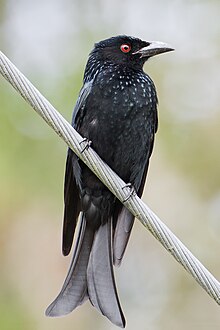| Spangled drongo | |
|---|---|

| |
| Conservation status | |
 Least Concern (IUCN 3.1) | |
| Scientific classification | |
| Domain: | Eukaryota |
| Kingdom: | Animalia |
| Phylum: | Chordata |
| Class: | Aves |
| Order: | Passeriformes |
| Family: | Dicruridae |
| Genus: | Dicrurus |
| Species: | D. bracteatus |
| Binomial name | |
| Dicrurus bracteatus Gould, 1843 | |
The spangled drongo (Dicrurus bracteatus) is a bird of the family Dicruridae. It is the only drongo to be found in Australia, where it can be recognised by its black, iridescent plumage and its characteristic forked tail. It feeds on insects and small vertebrates. It has complex and varied calls and is a mimic of the sounds it hears. It arrives in Queensland in late spring and breeds high in an isolated tree, producing three to five young each year.
Description
Its basically black plumage is iridescent with blue and purple highlights. Its eyes are crimson. The most remarkable characteristic of its appearance is its tail, which is described by Morcombe as "long, outcurved and forked" and on first examination looks like its feathers are crossed over – like crossing your fingers. Young drongos lack the highlights and spots and their eyes are dark brown.
Behaviour
| This section does not cite any sources. Please help improve this section by adding citations to reliable sources. Unsourced material may be challenged and removed. (January 2025) (Learn how and when to remove this message) |

The spangled drongo displays uninhibited and sometimes comical behaviour as it swoops and perches in search of insects, small birds, and occasionally, small skinks. When it seasonally visits urban areas, it is easily tamed by throwing small pieces of raw meat into the air, when it will accurately swoop and catch them midair.
Whilst this bird is often silent, it sometimes makes astonishingly loud, complex, and entertaining calls that may sound like a "sneeze". The spangled drongo is an amazing mimic, taking most of its vocabulary from the sounds heard in the vicinity and weaving them into a song.
The spangled drongo is the only drongo to be found in Australia. These birds are altitudinal and latitudinal migrants, and in the high-altitude areas around Brisbane in Queensland, they arrive in late spring and leave with their new crop of juveniles in midsummer. Nests are cup-shaped in open spaces, where predators have difficulty accessing them without being seen, 75% up the canopy. Each year, they produce three to five young.
Trivia
The unsuccessful racehorse Drongo was named after the bird, which led to the Australian slang insult "drongo" meaning "idiot".
Notes
- Although the meeting of the Zoological Society took place on 11 October 1842 and the volume of the Proceedings of the Zoological Society of London is dated 1842, the issue was not published until 1843.
References
- BirdLife International (2017). "Dicrurus bracteatus". IUCN Red List of Threatened Species. 2017: e.T22706996A111052288. doi:10.2305/IUCN.UK.2017-1.RLTS.T22706996A111052288.en. Retrieved 12 November 2021.
- Gould, J. (1842). "[Mr. Gould exhibited and characterized the following thirty new species of Australian Birds...]". Proceedings of the Zoological Society of London. 10: 132. doi:10.1111/j.1469-7998.1842.tb00069.x.
- Sclater, P.L. (1893). "List of the dates of delivery of the sheets of the 'Proceedings' of the Zoological Society of London, from the commencement in 1830 to 1859 inclusive". Proceedings of the Zoological Society of London: 436–440 .
- Morecomb, 2003 Field Guide to Australian Birds
- Spangled drongo | BirdLife Australia